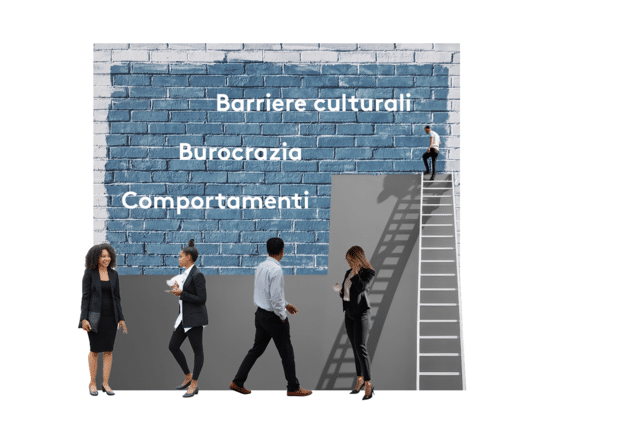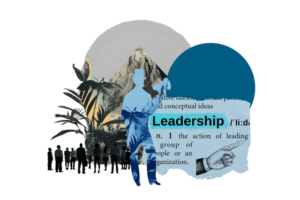In the world of work, until a few years ago, there was a great misconception that equated performance and well-being: those who produce a lot are doing well, are happy, and have found their fulfillment. Today, we have realized this is a false myth and that, on the contrary, very often, those who achieve higher (economic and career) results are victims of a toxic culture, which prevents them from developing and being well. So, we need to change the metrics that assess the value added by employees and the goals to be given to each. It is an essential cultural perspective change that goes through a change that Managers and CEOs can implement through a new leadership style.
Diane Laschet, Executive Business Coach, tells us about her experience.
At seventeen, my life came to a standstill: I had a high fever, and my joints hurt. I can’t do anything. Juvenile rheumatoid arthritis, the doctors call it. They give me a drug that stops the progress of the disease, but there is no cure; I have to live with it. Forever.
It was a hard blow, but I made a promise to myself: despite the pains, I would not allow my disease to stop me any longer; it had already stolen enough of my time. I intend to take it all back.
And I do. I study, graduate, work hard, and get a job.
Ten years after diagnosis, I got promoted to Manager managing a team of about twenty people.
After two more, I got promoted again; I became the nationwide Manager of six stores of the brand I work for, and my team now reaches about sixty people.
I work very, very hard; I want at all costs to prove that I am a person of worth despite my illness. I don’t want anything in the world for someone to use something I am not guilty of to tell me that I am incapable. Because I can do it. Under the guise of learning and growing, I always say yes, I do my job and my boss’s job, too. The colleagues notice my commitment and dedication, praise me, and take me as an example. I still grow: I am the right-hand man to the CEO of a multinational company. But I still have a lot to prove. I don’t stop.
I work more and more days, nights, weekends. I’m exhausted, but I don’t stop. I can’t sleep anymore. My family started to notice my discomfort. I replied that they didn’t understand and that I had to do this to get there. I keep working. I tend to be mean to my co-workers and act like a bully, as I have seen and seen all the people who have gotten ahead around me do. I always continue; I put off rest until the weekend, the end of the project, or the next vacation.
I am exhausted.
A weariness that won’t go away, from which I can’t recover because I can’t detach. I don’t know how to disconnect.
Then, I found out that this fatigue has a name: burnout.
It took me some time to recover, and now, after so many years, I can’t help but wonder: why didn’t I want to protect my mental health with the same energy with which I took care of my physical health?
Perform better, feel better?
In 2022, WHO stated that more than 300 million people worldwide suffer from work-related mental disorders and that one in four workers across all hierarchical levels believe that work negatively affects their lives. According to data from the Future Forum Pulse 2023 Report, burnout is a condition that now touches 42% of the workforce, which is also up from the highest peak reported to date, which dates back to May 2021.
But why did it have to come so far to raise attention to mental well-being in the office? Why did I have to go to such lengths?
I think my experience as a person with first a physical and then a psychological condition sums up the issue: the difference is between what is seen, which is objective (such as juvenile rheumatoid arthritis), and what is not seen, which is intangible (such as burnout).
If I, in the course of my career, had stopped and said that my body, because of my pathology, did not allow me to do something, no one would have objected; in fact, they would probably even have complimented me on how I was able to handle my situation; if, however, I had pointed out that it was my head that gave out, I would have been told that I was not strong enough, that I did not have a strong enough sense of belonging. Perhaps my illness at that point would have backfired: that is the result of putting a person with a disability in a position of responsibility.
Companies have only one option to solve this divergence: to invest in people.
In my career, I have often seen workers, at whatever level, treated like athletes: pushed to do better, better and better, and praised every time they broke their records. But while it is valid for workers and athletes alike that physical well-being promotes high performance, it is equally correct that high performance is not always accompanied by good mental health (think, again to stay in the sports world, of the decision by Simone Biles, the most muscular gymnast ever, to retire from the Olympics in 2021).
In his article The Case for Investing More in People, Eric Garton points out that in recent years, despite the great help of technology and the drive to grow relentlessly, the reality is that people’s productivity has remained roughly stable and, in any case, shallow.
This means that in recent years, we have created an underperforming and, at the same time, very sick working society.
So, there is a widespread need from which we can no longer shy away: to change the metrics by which employees are evaluated, shift from performance appraisal to personal growth appraisal, and create a work environment focused on well-being.

The environment we are happy to work in: how is it achieved?
In the article above, Garton gives three parameters that must be considered to create a healthier work environment: salaries, time and energy.
I have thirty years of experience in the corporate world behind me, fifteen of them as CEO, and who, after training, became an executive coach, would add one more: leadership.
READ ALSO: LEADERSHIP E CAMBIAMENTO UNA QUESTIONE DI STILE E UN PERCORSO PER STEP
While it is true that change can come from the top and bottom, it is equally unquestionable that those at the top of organizations also have the task of leading by example and being a spokesperson for a new context that is to be realized.
Therefore, good leaders are needed, and the skills to be good leaders are changing: operational, financial and technical skills are undoubtedly relevant, but human and soft skills are increasingly necessary. Indeed, the excellent leader today knows that if there are no good people in the team, there are no profits; that it is essential to grow sales but also to help people succeed; that high productivity is not necessarily a measure of well-being but can hide a sign of nervous exhaustion; that employee wellness programs, with yoga classes and mindfulness sessions, are of little use if they are not accompanied by a corporate culture committed to human sustainability.
The good leader knows that work is not what defines the value of life but only one aspect of a life well lived.
Getting down to specifics, however, one must be aware that making mental well-being a systemic feature of the world of work requires systemic solutions.
The challenges facing CEOs and managers will mainly concern three areas:
– Cultural barriers: such as the “performance society” conception that leads to hiding mental and physical discomfort for fear of not being considered up to par
– Bureaucracy: to address needs for a better work-life balance, such as flexibility or intelligent working.
– Behavior: to establish a new way of working and a new work culture that is functional in spreading the principles of a healthier and more sustainable organizational environment for people.
This is not an easy or quick path to put in place: if the principles we want to build on now are those of sharing, communication, and protection of individuals, then transformation can only occur through co-creation that includes all the people involved, which focuses on teamwork.
In my experience, I have seen firsthand how much more effectively this context of change can be managed with the help of a coach: to contribute to the long-term success of an organization, one must change not only how one works but also why one does it. Having someone at the side of the team or the entire organization to help set goals, work on behaviors, and manage one’s own and others’ emotions can be very helpful in charting the way within a situation that might otherwise be confusing and relapse in the name of efficiency, into mechanisms that are now innate but not at all virtuous.
If we try to realize a different world of work today, our children and grandchildren, looking back to 2023, will not see a historical moment of collective exhaustion but a turning point where we dared to stop and change things.





